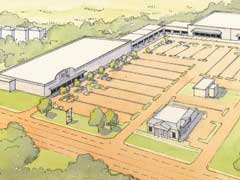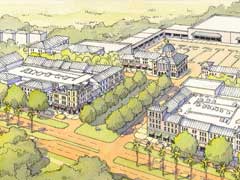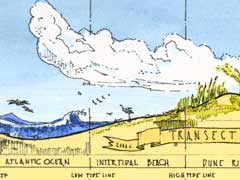Is this the future of planning & settlement in the Lowcountry?
 As one walks, cycles, kayaks, boats, or drives throughout the Lowcountry Region of the Southeast, complementary natural landscapes and settlement patterns combine to form an inimitable experience. Traditional settlement patterns such as Historic Beaufort, Historic Charleston, Historic Rockville, Historic Bluffton, and Historic Savannah attract locals and visitors, alike, because they are places worth caring about. In fact, most of the places in the Lowcountry that people care about are those that emanate a “historic” or traditional settlement pattern of the 17th, 18th, and 19th centuries.
As one walks, cycles, kayaks, boats, or drives throughout the Lowcountry Region of the Southeast, complementary natural landscapes and settlement patterns combine to form an inimitable experience. Traditional settlement patterns such as Historic Beaufort, Historic Charleston, Historic Rockville, Historic Bluffton, and Historic Savannah attract locals and visitors, alike, because they are places worth caring about. In fact, most of the places in the Lowcountry that people care about are those that emanate a “historic” or traditional settlement pattern of the 17th, 18th, and 19th centuries.
 Conversely, for the past 50 years, the predominant pattern of human settlement in the Lowcountry has taken the form of conventional suburban development, which has defined a comprehensive planning system characterized by single-use zones (housing pod, the shopping center, the business park, the large church, the isolated school) that are connected by a dendritic pattern of thoroughfares designed for the rapid movement of cars, creating a public realm (space between buildings) which is unfriendly to the pedestrian and dominated by the automobile. In the process of implementation, the conventional suburban development promotes single-use, automobile-dominated land use patterns, which, in return, generates sprawl. The negative effects of suburban sprawl include: dependence on foreign oil; declines in air and water quality; an epidemic of obesity and diabetes; places not worth caring about; traffic congestion and the high cost of commuting; unnecessary land consumption; and places that are more expensive for municipalities to serve than those built according to traditional neighborhood development patterns of the past.
Conversely, for the past 50 years, the predominant pattern of human settlement in the Lowcountry has taken the form of conventional suburban development, which has defined a comprehensive planning system characterized by single-use zones (housing pod, the shopping center, the business park, the large church, the isolated school) that are connected by a dendritic pattern of thoroughfares designed for the rapid movement of cars, creating a public realm (space between buildings) which is unfriendly to the pedestrian and dominated by the automobile. In the process of implementation, the conventional suburban development promotes single-use, automobile-dominated land use patterns, which, in return, generates sprawl. The negative effects of suburban sprawl include: dependence on foreign oil; declines in air and water quality; an epidemic of obesity and diabetes; places not worth caring about; traffic congestion and the high cost of commuting; unnecessary land consumption; and places that are more expensive for municipalities to serve than those built according to traditional neighborhood development patterns of the past.
 So, the question becomes: If the past fifty years of settlement in the Lowcountry has been dominated by the conventional suburban development model, what is the model for the next fifty years? The answer, in our opinion, is the retrofit of suburbia – or the urbanizing of our suburbs.
So, the question becomes: If the past fifty years of settlement in the Lowcountry has been dominated by the conventional suburban development model, what is the model for the next fifty years? The answer, in our opinion, is the retrofit of suburbia – or the urbanizing of our suburbs.
The retrofit of suburbia is defined as the redevelopment of the conventional suburban development pattern into a pattern that is more sustainable. Jurisdictions across the country and the world are placing emphasis on the retrofit of their suburbs as the following forces are driving this movement: reduced percentages of households with children and a growing market for multiunit housing in the suburbs; continued growth in the percentage of jobs in suburban locations; rising gas prices making housing on the periphery less affordable; and local smart growth policies and transit investments that are limiting sprawl and redirecting growth to existing infrastructure. By seeking to create the basis for change beyond their immediate property lines, such projects offer the best chance to overcome entrenched resistance and help suburbs evolve to meet changing needs – or more simply, make them adaptable to future generations of population growth and demand. Such projects are helping to improve connectivity and the sense of place, meet affordable housing needs, and mitigate congestion.
 Additionally, in this new economy, political jurisdictions are constantly searching for new creative sources of revenue and fiscally responsible methods to service existing and future populations. The retrofit of suburbia achieves both of the aforementioned goals as it directs growth in areas complete with existing infrastructure (roadways, water, sewer, utilities) and existing municipal service (police, fire, EMS, and solid waste collection), while yielding more revenue for the taxing entities (property tax, school district, accommodations tax, business license fees, hospitality tax) than the existing use of the property.
Additionally, in this new economy, political jurisdictions are constantly searching for new creative sources of revenue and fiscally responsible methods to service existing and future populations. The retrofit of suburbia achieves both of the aforementioned goals as it directs growth in areas complete with existing infrastructure (roadways, water, sewer, utilities) and existing municipal service (police, fire, EMS, and solid waste collection), while yielding more revenue for the taxing entities (property tax, school district, accommodations tax, business license fees, hospitality tax) than the existing use of the property.
When evaluating how we will cope with the changes that the Lowcountry faces in regards to the existing built environment, the suburban sprawl land use and transportation model is the antithesis of fiscal responsibility: creative sources of revenue, energy efficiency, environmental stewardship, and walkable urbanism. The Lowcountry should takes it cue from the City of Beaufort’s fabulous Boundary Street Master Plan and Code (the most progressive in the state in terms of the retrofit of suburbia) and demand a much more sustainable settlement pattern that is promoted by zoning and development standards as well as public-private partnerships. There is a clear recognition that growth presents immense challenges in terms of solving the existing and future growth issues in the Lowcountry, and this shift in mentality and policy is exactly what will bring the results we need at this critical moment.
This article was written for Lowcountry Weekly by the Congress for the New Urbanism – Carolinas Chapter.








